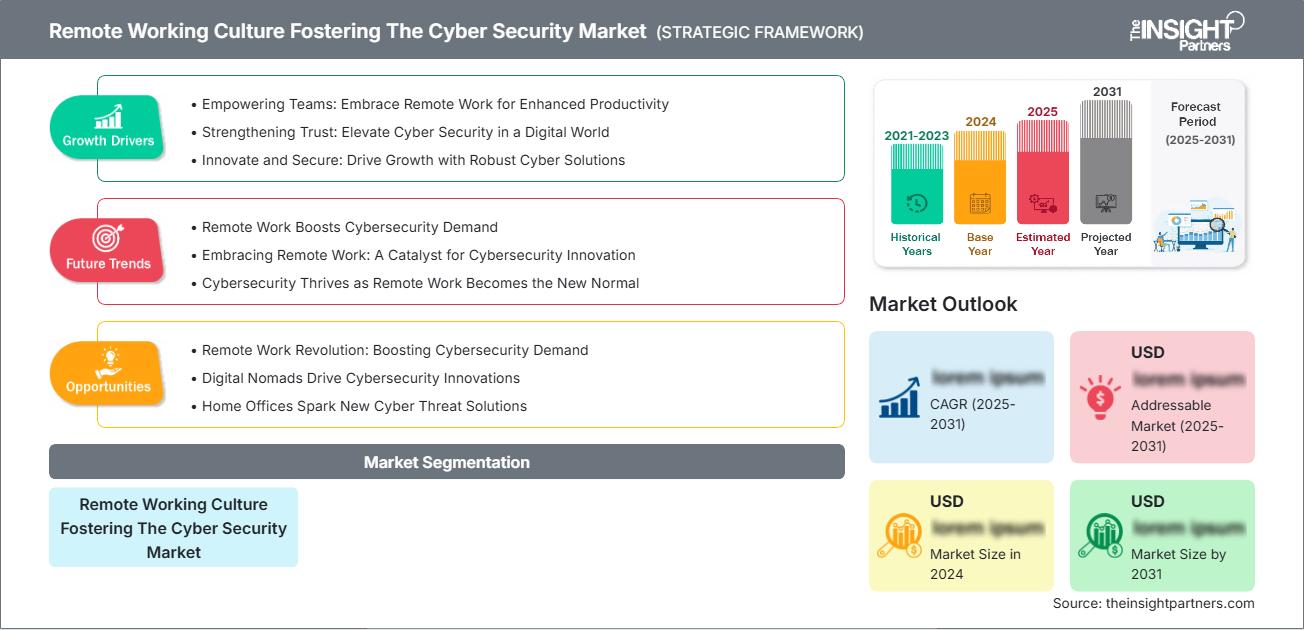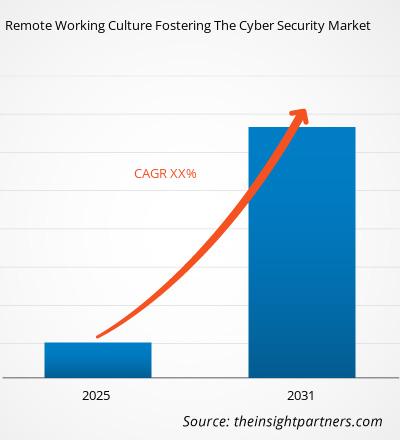Las soluciones de ciberseguridad protegen contra el uso ilegal o no autorizado de datos electrónicos, y los servicios de ciberseguridad son los procesos fundamentales para lograr la seguridad y protegerse contra las ciberamenazas comunes. Las soluciones de ciberseguridad se centran en el malware, el ransomware, el phishing y los ataques de denegación de servicio distribuido (DDoS) mediante una amplia gama de medidas de seguridad de red diseñadas para proteger la red, los datos y el sistema. Muchas de las soluciones de ciberseguridad disponibles incluyen amenazas persistentes avanzadas, inteligencia de amenazas, gestión de eventos de seguridad e información, gestión de vulnerabilidades, antivirus, firewall y puerta de enlace web segura.
Impacto de la COVID-19
Durante la pandemia de COVID-19, el gobierno y las autoridades regulatorias exigieron a las organizaciones públicas y privadas adoptar nuevas prácticas para el teletrabajo y el mantenimiento del distanciamiento social. Durante la pandemia, la digitalización de las operaciones se ha convertido en un nuevo Plan de Continuidad de Negocio (PCN) para diversas organizaciones a nivel mundial. Con la adopción de prácticas de teletrabajo, la adopción de dispositivos BYOD, la tendencia del teletrabajo (TFD) y la penetración global de internet, las organizaciones y las personas son propensas al uso de tecnologías digitales, lo que impulsa la necesidad de soluciones de ciberseguridad para minimizar el riesgo de ciberataques.
Obtendrá personalización en cualquier informe, sin cargo, incluidas partes de este informe o análisis a nivel de país, paquete de datos de Excel, así como también grandes ofertas y descuentos para empresas emergentes y universidades.
Cultura de trabajo remoto que fomenta el mercado de la ciberseguridad y su geografía (América del Norte, Europa, Asia Pacífico, América del Sur y América Central): Perspectivas estratégicas

-
Obtenga las principales tendencias clave del mercado de este informe.Esta muestra GRATUITA incluirá análisis de datos, desde tendencias del mercado hasta estimaciones y pronósticos.
Regulaciones clave
Las diversas normas están diseñadas para mejorar la ciberseguridad y contribuir a la gestión de riesgos. Por ejemplo, las Normas Federales de Procesamiento de la Información (FIPS) 140-2 y los Requisitos de Seguridad para Módulos Criptográficos establecen requisitos estándar para todos los sistemas de seguridad criptográficos utilizados por organizaciones federales para proteger datos confidenciales o valiosos. Grupos internacionales, regionales, nacionales, industriales y gubernamentales desarrollan normas de ciberseguridad. La misión principal de una organización de desarrollo de normas (SDO) es el desarrollo de normas de consenso voluntario a nivel internacional, regional o nacional. Algunas de las normas de cumplimiento de ciberseguridad que forman una base sólida para cualquier estrategia de ciberseguridad son la Ley Federal de Gestión de la Seguridad de la Información (FISMA), el Suplemento al Reglamento Federal de Adquisiciones de Defensa (DFARS), la Ley de Portabilidad y Responsabilidad del Seguro Médico (HIPAA), la ISO 22301, la ISO/IEC 27001 y el Marco de Ciberseguridad del NIST (CSF).
Tendencias regionales
En términos de región, América del Norte tiene una participación significativa, seguida de Europa y Asia Pacífico (APAC) en el mercado global de soluciones de ciberseguridad. La presencia de varios proveedores destacados de soluciones de ciberseguridad en la región contribuye al crecimiento del mercado. Actores clave como IBM, Microsoft Corporation, Oracle Corporation y Fortinet ofrecen soluciones y servicios de ciberseguridad mejorados para satisfacer las necesidades de los clientes. Además, el gobierno está implementando diversas iniciativas en países como Estados Unidos, Canadá y México para fortalecer su infraestructura de red y minimizar el riesgo de ciberataques. Por ejemplo, el Gobierno de Canadá (GC), en su Plan Estratégico de Operaciones Digitales (DOSP) para 2021-2024, aprueba un plan empresarial trienal con visión de futuro para establecer la dirección estratégica de la gestión integrada de servicios, información, datos, tecnología de la información (TI) y ciberseguridad. Estas iniciativas gubernamentales contribuyen al crecimiento del mercado de soluciones de ciberseguridad en América del Norte.
Se espera que el mercado de soluciones de ciberseguridad en APAC crezca a la mayor tasa de crecimiento anual compuesta (TCAC) durante el período de pronóstico. El aumento de ciberataques a infraestructuras gubernamentales y críticas en APAC se traduce en una mayor inversión en tecnologías de ciberseguridad para fortalecer las capacidades de detección y respuesta ante amenazas. Según el Índice de Inteligencia de Amenazas IBM X-Force, India registró el segundo mayor número de ciberataques, después de Japón, en APAC en 2021. Asimismo, según el informe, el sector financiero y de seguros fue el más atacado en India (60%), seguido de la manufactura y los servicios profesionales.
Cultura de trabajo remoto que fomenta la ciberseguridad
Cultura de trabajo remoto que fomenta el mercado de la ciberseguridad y geografía (América del Norte, Europa, Asia Pacífico, América del Sur y América Central) Perspectivas regionales del mercado
Los analistas de The Insight Partners han explicado detalladamente las tendencias y los factores regionales que influyen en el mercado de la ciberseguridad, su impacto en la cultura del trabajo remoto y su ubicación geográfica (Norteamérica, Europa, Asia Pacífico, Sudamérica y Centroamérica) durante el período de pronóstico. Esta sección también analiza los segmentos de mercado y la ubicación geográfica de la ciberseguridad, su impacto en la cultura del trabajo remoto y su impacto en la cultura del trabajo remoto en Norteamérica, Europa, Asia Pacífico, Oriente Medio y África, y Sudamérica y Centroamérica.
Cultura de trabajo remoto que fomenta el mercado de la ciberseguridad y geografía (América del Norte, Europa, Asia Pacífico, América del Sur y América Central) Alcance del informe de mercado
| Atributo del informe | Detalles |
|---|---|
| Tamaño del mercado en 2024 | US$ XX millones |
| Tamaño del mercado en 2031 | US$ XX millones |
| CAGR global (2025-2031) | XX% |
| Datos históricos | 2021-2023 |
| Período de pronóstico | 2025-2031 |
| Segmentos cubiertos | Por la cultura del trabajo remoto que fomenta el mercado de la ciberseguridad |
| Regiones y países cubiertos |
América del norte
|
| Líderes del mercado y perfiles de empresas clave |
|
Cultura de trabajo remoto que fomenta el mercado de la ciberseguridad y geografía (América del Norte, Europa, Asia Pacífico, América del Sur y Central) Densidad de actores del mercado: comprensión de su impacto en la dinámica empresarial
La cultura del teletrabajo impulsa el mercado de la ciberseguridad y su geografía (Norteamérica, Europa, Asia Pacífico, Sudamérica y Centroamérica). El mercado está creciendo rápidamente, impulsado por la creciente demanda de los usuarios finales debido a factores como la evolución de las preferencias de los consumidores, los avances tecnológicos y una mayor conciencia de los beneficios del producto. A medida que aumenta la demanda, las empresas amplían su oferta, innovan para satisfacer las necesidades de los consumidores y aprovechan las tendencias emergentes, lo que impulsa aún más el crecimiento del mercado.

- Obtenga la cultura del trabajo remoto que fomenta el mercado de la ciberseguridad y la geografía (América del Norte, Europa, Asia Pacífico y América del Sur y Central) Descripción general de los principales actores clave del mercado
Análisis de la competencia y desarrollos recientes
Algunas de las empresas más destacadas que operan en el mercado son Fortinet; Oracle Corporation; Microsoft Corporation; Micro Focus International plc; Rapid7; NortonLifeLock Inc. (Symantec Corporation); Trend Micro Inc.; FireEye; Check Point Software Technologies; Cisco Systems, Inc.; e International Business Machines Corporation. Estas empresas se centran en estrategias de lanzamiento de productos para mantenerse competitivas y ampliar su cartera de clientes. A continuación, se mencionan algunos de los desarrollos recientes:
En octubre de 2021, Comtech Telecommunications lanzó una nueva línea de productos y servicios de ciberseguridad para respaldar los esfuerzos de monitoreo y evaluación de amenazas, capacitación y desarrollo de la fuerza laboral de los clientes.
En noviembre de 2021, Check Point Software Technologies Ltd. lanzó su plataforma unificada de ciberseguridad de última generación, Check Point R81. Esta nueva plataforma ofrecerá prevención autónoma de amenazas, diseñada para toda la empresa distribuida, lo que permitirá al personal de TI gestionar los entornos de red más complejos y dinámicos de forma rápida y eficiente.
En septiembre de 2021, Bharti Airtel Ltd. lanzó un conjunto de soluciones de ciberseguridad para empresas grandes, medianas y pequeñas a medida que migran a plataformas digitales y en la nube, lo que aumenta la necesidad de proteger los datos y la información de los ataques en línea.
En julio de 2021, Google Cloud anunció dos nuevas ofertas de seguridad (VM confidenciales y cargas de trabajo aseguradas) para que los gobiernos brinden a los clientes herramientas de seguridad avanzadas para respaldar el cumplimiento y la confidencialidad de los datos.
- Análisis histórico (2 años), año base, pronóstico (7 años) con CAGR
- Análisis PEST y FODA
- Tamaño del mercado, valor/volumen: global, regional y nacional
- Industria y panorama competitivo
- Conjunto de datos de Excel
Informes recientes
Testimonios
Razón para comprar
- Toma de decisiones informada
- Comprensión de la dinámica del mercado
- Análisis competitivo
- Información sobre clientes
- Pronósticos del mercado
- Mitigación de riesgos
- Planificación estratégica
- Justificación de la inversión
- Identificación de mercados emergentes
- Mejora de las estrategias de marketing
- Impulso de la eficiencia operativa
- Alineación con las tendencias regulatorias






















 Obtenga una muestra gratuita para - Cultura de trabajo remoto que fomenta el mercado de la ciberseguridad y su geografía (América del Norte, Europa, Asia Pacífico, América del Sur y América Central)
Obtenga una muestra gratuita para - Cultura de trabajo remoto que fomenta el mercado de la ciberseguridad y su geografía (América del Norte, Europa, Asia Pacífico, América del Sur y América Central)